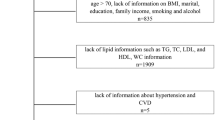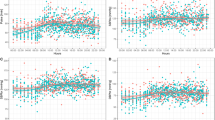Abstract
The objective of this study was to compare the Atherogenic Index of Plasma (AIP) values as indicators of subclinical atherosclerosis among 124 patients with erectile dysfunction, which was thought to be vasculogenic and 126 control subjects who had no erectile dysfunction, and to compare cardiac performance values between both the groups using exercise stress tests (EST). Erectile function was assessed using the International Index of Erectile Function (IIEF-5) questionnaire form. AIP values were studied and compared between patients with ED (IIEF < 22) and those without ED (IIEF > 22) using the log10 TG/HDL-C formula. In addition, the correlation between the severity of ED and AIP was investigated according to IIEF-5 scoring. Metabolic equivalent (MET) values, maximal heart rates (max HR), and heart rate recovery (HRR) were evaluated with effort tests. AIP values were significantly higher in the ED group than in the control group (0.45 ± 0.27, and 0.37 ± 0.27; p = 0.015). According to IIEF-5 scoring, AIP values increased as ED scores decreased. In the EST, MET score and max HR values were significantly lower in the ED group (METs: 11.1 ± 2.2, and 11.6 ± 2.2; p = 0.045; Max HR: 162.8 ± 6.1, and 165 ± 8.7; p = 0.019). Although not statistically significant, HRR values were lower in the ED group. Higher AIP values were found in the ED group, and a positive correlation was established between AIP and the severity of ED. In addition, lower performance during the EST and lower HRR values, again in the ED group, confirms cardiac interaction with ED. These results indicate the importance of referral of patients with ED from urology clinics to cardiology units for risk determination and cardiac assessment, even if they areasymptomatic.
This is a preview of subscription content, access via your institution
Access options
Subscribe to this journal
Receive 8 print issues and online access
$259.00 per year
only $32.38 per issue
Buy this article
- Purchase on Springer Link
- Instant access to full article PDF
Prices may be subject to local taxes which are calculated during checkout


Similar content being viewed by others
References
Çayan S, Kendirci M, Yaman Ö, Aşçı R, Orhan İ, Usta MF, et al. Prevalence of erectile dysfunction in men over 40 years of age in Turkey: results from the Turkish Society of Andrology Male Sexual Health Study Group. Turk J Urol. 2017;43:122–9.
Akkus E, Kadioglu A, Esen A, Doran S, Ergen A, Anafarta K, et al. Prevalence and correlates of erectile dysfunction in Turkey: a population-based study. Eur Urol. 2002;41:298–304.
Lue TF. Erectile dysfunction. N Engl J Med. 2000;342:1802–13.
Persu C, Cauni V, Gutue S, Albu ES, Jinga V, Geavlete P. Diagnosis and treatment of erectile dysfunction-a practical update. J Med Life. 2009;2:394–400.
Kendirci M, Nowfar S, Hellstrom WJ. The impact of vascular risk factors on erectile function. Drugs Today (Barc). 2005;41:65–74.
Dobiásová M. AIP–atherogenic index of plasma as a significant predictor of cardiovascular risk: from research to practice. Vnitr Lek. 2006;52:64–71.
Bhardwaj S, Bhattacharijee J, Bhatnagar MK, Tyagi S. Atherogenic index of plasma, castelli risk index and atherogenic coefficient - new parameters in assessing cardiovascular risk. Int J Pharm Biol Sci. 2013;3:359–64.
Niroumand S, Khajedaluee M, Khadem-Rezaiyan M, Abrishami M, Juya M, Khodaee G, et al. Atherogenic Index of Plasma (AIP): a marker of cardiovascular disease. Med J Islam Repub Iran. 2015;29:240.
Oztürk Mİ, Koca O, Keleş MO, Güneş M, Kaya C, Karaman MI. Question for a questionnaire: the International Index of Erectile Function. Int J Impot Res. 2011;23:24–6.
Kennedy JW, Cobb LA, Samson WE. Robert Arthur Bruce, MD. Circulation. 2005;111:2410–2.
Kligfield P, Lauer MS. Exercise electrocardiogram testing: beyond the ST segment. Circulation. 2006;114:2070–82.
Friedewald WT, Levy RI, Fredrickson DS. “Estimation of the concentration of low-density lipoprotein cholesterol in plasma, without use of the preparative ultracentrifuge,”. Clin Chem. 1972;18:499–502.
DeBusk R, Drory Y, Goldstein I, Jackson G, Kaul S, Kimmel SE. Management of sexual dysfunction in patients with cardiovascular disease: recommendations of the Princeton Consensus Panel. Am J Cardiol. 2000;86:175–81.
Dogru MT, Basar MM, Haciislamoglu A. The difference of heart rate recovery between males with and without erectile dysfunction. Ann Noninvasive Electrocardiol. 2010;15:223–9.
Dhabuwala CB, Kumar A, Pierce JM. Myocardial infarction and its influence on male sexual function. Arch Sex Behav. 1986;15:499–504.
Korpelainen JT, Kauhanen ML, Kemola H, Malinen U, Myllylä VV. Sexual dysfunction in stroke patients. Acta Neurol Scand. 1998;98:400–5.
Virag R, Bouilly P, Frydman D. Is impotence an arterial disorder? A study of arterial risk factors in 440 impotent men. Lancet. 1985;1:181–4.
Solomon H, Man JW, Wierzbicki AS, Jackson G. Relation of erectile dysfunction to angiographic coronary artery disease. Am J Cardiol. 2003;91:230–1.
Montorsi P, Ravagnani PM, Galli S, Salonia A, Briganti A, Werba JP, et al. Association between erectile dysfunction and coronary artery disease: matching the right target with the right test in the right patient. Eur Urol. 2006;50:721–31.
Montorsi P, Montorsi F, Schulman CC. Is erectile dysfunction the “tip of the iceberg” of a systemic vascular disorder? Eur Urol. 2003;44:352–4.
Jackson G, Boon N, Eardley I, Kirby M, Dean J, Hackett G. Erectile dysfunction and coronary artery disease prediction: evidence-based guidance and consensus. Int J Clin Pract. 2010;64:848–57.
Zhan Y, Xu T, Tan X. Two parameters reflect lipid-driven inflammatory state in acute coronary syndrome: atherogenic index of plasma, neutrophil-lymphocyte ratio. BMC Cardiovasc Disord. 2016;16:96.
Akbas EM, Timuroglu A, Ozcicek A, Ozcicek F, Demirtas L, Gungor A, et al. Association of uric acid, Atherogenic index of plasma and albuminuria in diabetes mellitus. Int J Clin Exp Med. 2014;7:5737–43.
Kalelioğlu T, Ünalan P, Kök B, Sözen Ş, Yüksel Ö, Akkuş M. Atherogenic index of plasma as a cardiovascular risk marker in manic, depressive, and euthymic stages of bipolar disorder. Turk Kardiyol Dern Ars. 2018;46:32–8.
Uslu AU, Kucuk A, Icli A, Cure E, Sakiz D, Arslan S, et al. Plasma atherogenic index is an independent indicator of subclinical atherosclerosis in systemic lupus erythematosus. Eurasia J Med. 2017;49:193–7.
Freeman JV, Dewey FE, Hadley DM, Myers J, Froelicher VF. Autonomic nervous system interaction with the cardiovascular system during exercise. Prog Cardiovasc Dis. 2006;48:342–62.
Gordon DJ, Leon AS, Ekelund LG, Sopko G, Probstfield JL, Rubenstein C, et al. Smoking, physical activity, and other predictors of endurence and heart rate response to exercise in asymtomatic hypercholesterolemic men. Am J Epidemiol. 1987;125:587–600.
Imai K, Sato H, Hori M, Kusuoka H, Ozaki H, Yokoyama H, et al. Vagally mediated heart rate recovery after exercise is accelerated in athletes but blunted in patients with chronic heart failure. J Am Coll Cardiol. 1994;24:1529–35.
Higgins JP, Higgins JA. Electrocardiographic exercise stress testing: an update beyond the ST segment. Int J Cardiol. 2007;116:285–99.
Cole CR, Blackstone EH, Pashkow FJ, Snader CE, Lauer MS. Heart rate recovery immediately after exercise as a predictor of mortality. N Engl J Med. 1999;341:1351–7.
Cole CR, Foody JM, Blackstone EH, Lauer MS. Heart rate recovery after submaximal exercise testing as a predictor of mortality in a cardiovascularly healthy cohort. Ann Intern Med. 2000;132:552–5.
Shetler K, Marcus R, Froelicher VF, Vora S, Kalisetti D, Prakash M, et al. Heart rate recovery: validation and MethodologicvIssues. J Am Coll Cardiol. 2001;38:1980–7.
Lipinski JM, Vetrovec GW, Froelicher VF. Importance of the first two minutes of heart ratevrecovery after exercise treadmill testing in predicting mortality and the presence of coronary artery disease in men. Am J Cardiol. 2004;93:445–9.
Jouven X, Empana JP, Schwartz PJ, Desnos M, Courbon D, Ducimetière P. Heart rate profile during exercise as a predictor of sudden death. N Engl J Med. 2005;352:1951–8.
Author information
Authors and Affiliations
Corresponding author
Ethics declarations
Conflict of interest
The authors declare that they have no conflict of interest.
Peer-review
Externally peer-reviewed.
Additional information
Publisher’s note: Springer Nature remains neutral with regard to jurisdictional claims in published maps and institutional affiliations.
Rights and permissions
About this article
Cite this article
Ermis, E., Ozbay Ozyilmaz, S., Salabas, E. et al. The relationship between erectile dysfunction and the Atherogenic Index of Plasma. Int J Impot Res 32, 462–468 (2020). https://doi.org/10.1038/s41443-019-0167-2
Received:
Revised:
Accepted:
Published:
Issue Date:
DOI: https://doi.org/10.1038/s41443-019-0167-2
This article is cited by
-
Association between cardiometabolic index and erectile dysfunction among US adults: a cross-sectional analysis of the National Health and Nutrition Examination Survey 2001-2004
International Journal of Impotence Research (2023)
-
Authors’ reply
International Journal of Impotence Research (2021)
-
Comment on “The relationship between erectile dysfunction and the atherogenic index of plasma”
International Journal of Impotence Research (2020)



